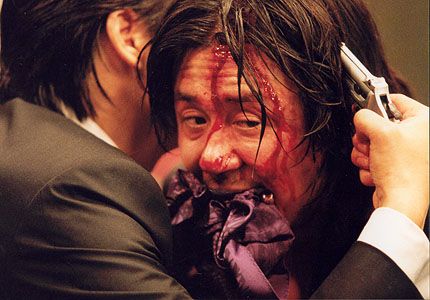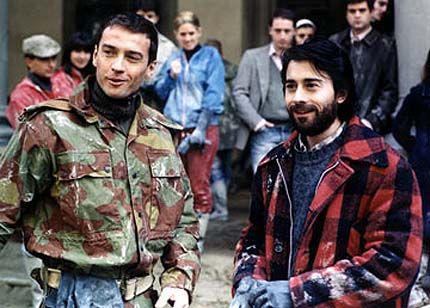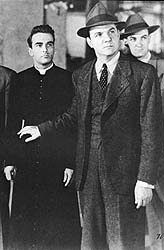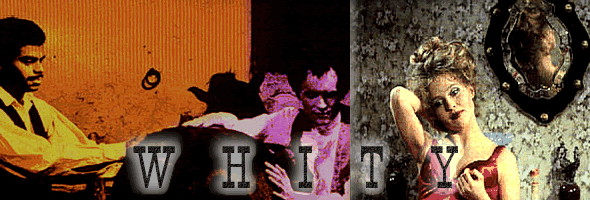
It’s been a while since I heard an audience scream like that.
Not like the thrill-shriekers that love horror films like they love roller coasters, but like an audience watching Henri-Georges Clouzot’s
Diabolique (1955)—exactly like that—and you either have seen the movie and know exactly what I mean, or it would be disastrous for me to spell it out.
Watching Michael Haneke’s latest
Caché (
Hidden) (2005) is very much like watching a Clouzot picture, but Haneke differs in one crucial way: there is no resolution to the story, no villain to pin it on, no explanation to the mystery. If you are one who needs this type of closure, then Cache is not for you. Haneke provokes us through his unconventional storytelling and demands that we appreciate the vibe of mystery for its own sake. “It’s the beauty of the mystery that allows us to live sane as we pilot our fragile bodies through this demolition-derby world,” writes Stephen King in the afterward to his novel
The Colorado Kid.
King’s words ring ironic throughout
Caché, because the films characters are unable to live with the mystery, and their wits are whittled away by the invisible hand of a blackmailer. Georges (Daniel Auteuil) and Anne Laurent (Juliette Binoche) begin receiving videotapes of them entering and leaving their house accompanied by child-like drawing of bloody faces. The threat is there, but not explicitly. Neither husband nor wife can figure out what the blackmailer wants from them, nor what he is blackmailing them about.
Is it even blackmail? Another videotape shows Georges’s childhood home; still another a hotel room. Georges tracks down the hotel room and discovers a childhood memory long forgotten: Majid, the son of two servants that worked for his family. Georges surmises that Majid and his son are behind these videotapes, but where is the proof, and where is the motive—and what are they after?
The suspense genre has been constantly evolving over the past fifty years. Think back to
Diabolique: the mystery is resolved. Virtually all mystery/suspense pictures before the 1960s had a large degree of closure. Beginning in the 1960s, the genre began to show signs of dissent.
Blow-Up (1969) leaves us wondering if he really photographed a murder, or whether it was David Hemmings’s imagination. Haneke continues the evolution by making the threat real, but by leaving the characters so far out in the cold that there’s little chance they’ll ever find the right path. The right path, in fact, never appears in the movie: all trails are as futile to Haneke.

The way the film develops, then, is through Georges’s psychological reaction to the tapes. Unsure of their intended meaning, his mind goes rampant through his subconscious, digging up all the guilt and shame that he had hidden for so long. The footage of him walking in and out of his house is meaningless, harmless, really, save for the fact that someone is nearby with a camera. Much like in
Rear Window (1954) when Scottie’s gaze is returned by Thorwald, Georges’s subconscious becomes his outer-shell. His and Anne’s need for a reason, for a motive—needs much like the audience’s—surfaces their own lack of trust in one another.
The reason why Haneke is successful with
Caché is that he hits at such a mundane vulnerability in us: there is nothing spectacular or fantastic about the terror; in fact, it seems to be created as much by Georges as it is by the mysterious cameraman. The mere sight of himself on film sets off a whole globe of paranoia.
Stephen King continues musing on the nature of mystery in his afterward: “Wanting might be better than knowing.” With cinematic villainy becoming increasingly more deranged and pathological, too, the stakes for the victims is changing as well. The innocent girl played by Ida Lupino in
Out of the Fog (1943) that is being harassed by John Garfield is no longer the case: innocence no longer exists, except in the minds of others. Georges proves that he finds himself guilty; his struggle for exoneration is as much about proving his innocence to his wife as it is proving himself guilty to himself.
Haneke’s direction is fitting. He utilizes static shots that leave the audience wondering, “Is this going to be a videotape or not?” Flashbacks, too, are subtly intertwined as to avoid easy pinpointing. With the villain a filmmaker himself, Haneke has fun toying with the audience as to who is filming which shot.
It is impossible for people, when talking about
Caché, not to mention the end of the film. And it’s no wonder—Hakeke is prevocational up until the last shot. People in the audience began shouting, “What? Is that it?” It’s been a long time since audience reaction after a movie could drown out a cell-phone. Speaking of which, not one went off during the entire movie. It’s been a while since that has happened.
 Rene Clair’s I Married a Witch (1942) is stupefyingly schlocky. Veronica Lake plays a 290-year-old witch that was burned by the puritans and buried under an oak tree that is to contain her spirit for eternity. A lightning bolt strikes the tree in the 1940s, however, releasing Lake’s ghost. Vengeful, she singles out Frederic March, whose ancestor was the one to burn Lake centuries earlier. She foils his marriage, clinches his election for governor, and then takes him down the aisle for herself. It should be ridiculous, but handled at Clair’s breakneck pace it finishes as fittingly absurd. Still, his earlier works such as À Nous La Liberté (1931) and Paris Qui Dort (1925) need less justification for their comedy to work. With I Married a Witch, you have to keep telling yourself, “Veronica Lake doesn’t look half bad for someone George Washington’s age.”
Rene Clair’s I Married a Witch (1942) is stupefyingly schlocky. Veronica Lake plays a 290-year-old witch that was burned by the puritans and buried under an oak tree that is to contain her spirit for eternity. A lightning bolt strikes the tree in the 1940s, however, releasing Lake’s ghost. Vengeful, she singles out Frederic March, whose ancestor was the one to burn Lake centuries earlier. She foils his marriage, clinches his election for governor, and then takes him down the aisle for herself. It should be ridiculous, but handled at Clair’s breakneck pace it finishes as fittingly absurd. Still, his earlier works such as À Nous La Liberté (1931) and Paris Qui Dort (1925) need less justification for their comedy to work. With I Married a Witch, you have to keep telling yourself, “Veronica Lake doesn’t look half bad for someone George Washington’s age.”















